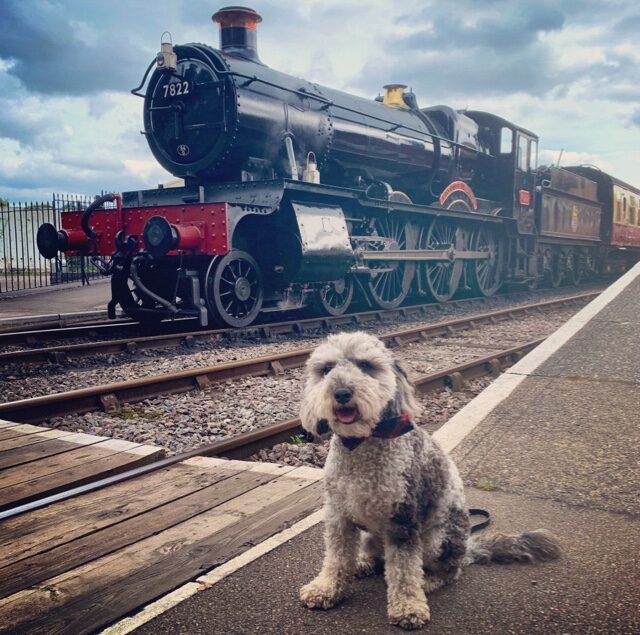
This week saw the second and third days of the RMT national rail strike and with them further disruption across the network. I hope that both sides can see their way to finding a solution. Locally we saw the cancellation of a steam hauled rail tour to Bournemouth and Weymouth on Thursday 23rd June 2022. In addition, Yoshi and I had our eyes on photographing a couple of excursion trains in the West Country on Saturday 24th June 2022. One of them, scheduled to have been hauled by a pair of Class 20’s diesels from Birmingham Snow Hill to Bishops Lydeard for the Weston Air Show and the West Somerset Railway, was of particular interest.
Yoshi took a look at his copy of The Ladybird Book Of British Railway Locomotives to learn all about the Class 20, or English Electric Type 1 as they would have been known as when the book was first published in 1958.


The English Electric Type 1, later to become Class 20, was introduced by British Railways between 1957 and 1968 and were one of the pioneering diesel locomotive types built for the BR Modernisation Plan of 1955. 228 members of the class were constructed intended for light passenger train work and freight haulage. Their construction was split between the English Electric Vulcan Foundry in Newton-Le-Willows and RSH in Newcastle. The design was similar to other locomotives found around the world with a single cab at one end and a long bonnet containing the power unit and electrical equipment. The class were initially employed in Scotland, London, South Yorkshire and Derbyshire. Issues around driver visibility and lack of work for smaller types of locomotives like the Class 20’s resulted in the locos running in pairs, coupled nose to nose with both cabs facing outwards. Most Class 20’s eventually transferred to work heavy coal trains in Scotland and Northern England.








By the 1980’s the Class 20’s found themselves being replaced on coal trains by newer and more powerful freight locomotives such as the Class 56 and Class 58 resulting in many withdrawals from service, although some found work on passenger services to seaside destinations, Channel Tunnel construction trains, weed killing trains whilst four were sold to a private operator in France. Later, following railway privatisation in the UK, Direct Rail Services (DRS) employed Class 20’s on their workings for a number of years. Private operators have continued to use examples of the class for Rail Head Treatment Trains (RHTT) and in transferring rolling stock around the country.




If you’re wondering what a pair of Class 20 diesels on a passenger train would look like, here’s a short video clip of Class 20 locomotives No.’s 20096 and 20107 ‘Jocelyn Fielding 1940 – 2020’ top and tailing with Class 37 No. 37667 (running as D6851) ‘Flopsie’ while working 1Z36 The Jolly Slateman rail tour on 20th November 2021. The tour, run by Intercity, took the 20’s from Derby to Blaenau Ffestiniog and Llandudno Junction and return.
Going back in time, here’s a video clip of another Class 20 hauled rail tour from 2008 when DRS Class 20’s No’s 20307 and 20310, with Class 57 No. 57601 at the rear of the train to provide Electric Train Heating (ETH), travelled from Crewe to Weymouth with Spitfire Railtours organised “The Way-farer” excursion train on April 19th 2008. I can remember planning on filming the return leg of the tour from the footbridge at Upwey, but on arrival I was politely asked if I wouldn’t mind joining a gallery of photographers at the London end of the down platform as they wished to use the footbridge to frame the train and didn’t want some idiot ruining their shot. I was happy to oblige, and think that actually it’s resulted in a better view of the train running through the station. On the same day the Chester Model Railway Club and the Ffestiniog Railway ( Dee & Mersey Group) hired Wrexham and Shropshire liveried Class 67 No’s 67014 and 67015 to top and tail The Dorset Coat Express from Hooton to Poole and return.
Returning to 2022 and last Saturday, I spent the morning making an effort with clearing an old water tank and other accumulated rubbish from our loft to free up space for an often talked about model railway layout. Yoshi isn’t happy climbing the loft ladder and sits at the bottom of it looking up and making the occasional comment of disapproval.
Despite being a rail strike day, on Saturday afternoon, as a change from another visit to the recycling centre, I thought I would pop over to the Southampton area to photograph GBRf Class 69 No. 69001, not realising it had departed Southampton Western Docks 158 minutes ahead of schedule. Instead I saw Freightliner Class 66 No.’s 66415 ‘You Are Never Alone’ and 66957 ‘Stephenson Locomotive Society 1909 -2009’ double heading on 4Z21 0918 Trafford Park FLT to Southampton MCT and GBRf Biffa liveried Class 66 No. 66783 working 4Z04 1036 Trafford Park to Southampton Western Docks.

We also had a quick look in at Freightliner’s Southampton Maritime depot and Eastleigh.










Swanage Roads to Rail
Saturday evening saw us visiting Norden where the Swanage Railway were holding their Roads to Rail event which included working traction engines, road rollers, showman’s engines and SR 2-6-0 U Class No. 31806 alongside vintage fairground fun, live music and plenty of refreshments. Yoshi didn’t much care for the steam traction engines with all their whistling, hissing and clunking so we decided that we wouldn’t stay too late. We managed to grab the following photos in between eating and drinking.











Thanks for joining us this week – we’ll be back in seven days with more witterings!
